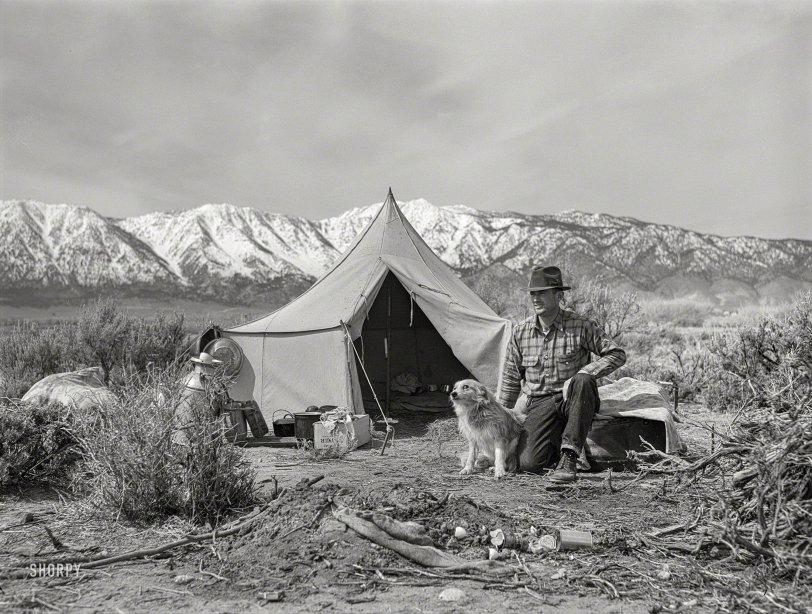


Framed or unframed, desk size to sofa size, printed by us in Arizona and Alabama since 2007. Explore now.
Shorpy is funded by you. Patreon contributors get an ad-free experience.
Learn more.

- Lofty addition
- In 1912
- Keenan Building
- Six years old
- Taken from the P.J. McArdle Roadway?
- It stood only 47 years
- Three track mind
- Incline to the right
- Reach for the sky, 1912 style
- No clean sweep
- Same Job Title, Same Face
- Sadly Lost
- Beautiful ...
- Where you get your kicks
- Aim High
- Pueblo Revival sisters
- Pueblo Neoclassicism
- Milk Man
- Regional dialect.
- Spielberg's inspiration
- Great Photo
- Loaf Story
- Do you still have the Rakes category?
- Could almost be a scene from the 1957 movie 'Hell Drivers'
- The Wages of Fear.
- Conspicuous by their absence
- Got Milk?
- All that aluminum
- No lefties
- Smoke 'em if you've got 'em
Print Emporium
Every Dog Has His Doubts: 1940

March 1940. "Basque sheepherder camped on the range. Dangberg Ranch, Douglas County, Nevada." Photo by Arthur Rothstein for the Farm Security Administration. View full size.
Minder of Hooved Locusts
The history of sheep herding is colorful, but livestock destroyed the alpine meadows and forests in the high Sierras. One of the major reasons that John Muir formed the Sierra Club in 1892 was to seek protection from sheep and cattle grazing.
Even today, 100 years after most grazing stopped in the high Sierras, the alpine meadows that I have visited have large areas of barren, eroded mineral soil and little grass. It's hard to imagine that they were once grassy meadows.
From https://vault.sierraclub.org/john_muir_exhibit/life/muir_biography.aspx
Through a series of articles appearing in Century magazine, Muir drew attention to the devastation of mountain meadows and forests by sheep and cattle. With the help of Century's associate editor, Robert Underwood Johnson, Muir worked to remedy this destruction. In 1890, due in large part to the efforts of Muir and Johnson, an act of Congress created Yosemite National Park. Muir was also personally involved in the creation of Sequoia, Mount Rainier, Petrified Forest and Grand Canyon national parks. Muir deservedly is often called the "Father of Our National Park System ".
Side-Eye
Canine thought-bubble: "If the human eats one more can of beans, I'm sleeping outside tonight."
Basque shepherds also summered in the mountain meadows north of Flagstaff, AZ, and their graffiti carved in white aspen bark can still be found on the San Francisco peaks. My son and I spent many weekends hiking that country and we would often find what we called "cowboy camps" -- most likely Basque shepherd camps like this one.
Among the fire rings and middens we found countless tin cans. The majority were indistinguishable, their labels having been burned or rotted off, but we could easily identify Prince Albert tobacco tins, condensed milk cans, sardine tins, medicine and spice jars or bottles, and occasional pot lids, lantern parts, and utensils. We enjoyed reconstructing their daily lives and habits from our forensic kitchen diggings.
In Flagstaff, my home for 20+ years, we knew several descendants of Basque herders. Most lived in the little neighborhood just south of the Santa Fe railroad tracks. To this day, the ruins of a Basque handball court stands behind the Tourist Home Hotel -- formerly a rooming house catering to Basques.
The mountain west is a richer place for their lives and work. Fascinating people.
The University of Nevada-Reno curates the history of these immigrant people at https://basquebooks.blogs.unr.edu/category/basques-in-arizona/
Watch out!
Unlike his master, the dog is keeping a wary eye on the photographer.
Thoughts of a Basque dog
“On the whole, I’d rather be in Bilbao!"
Stink Eye!
Never gets old!
Especially from this man's best friend
Head to the Hollywood hills
If a casting director or movie producer had also been camping in the same area this very handsome sheepherder may have ended up with many fans to herd instead of sheep.
All dogs go to Heaven
And people only if their dogs vouch for them at the gate.
A tidy campsite
But, then, he probably spends months there. A lonely life, being an open range shepherd, but one the Basques seem to have embraced wholeheartedly.
I'll bet that pup gets spoken to a lot.
























On Shorpy:
Today’s Top 5